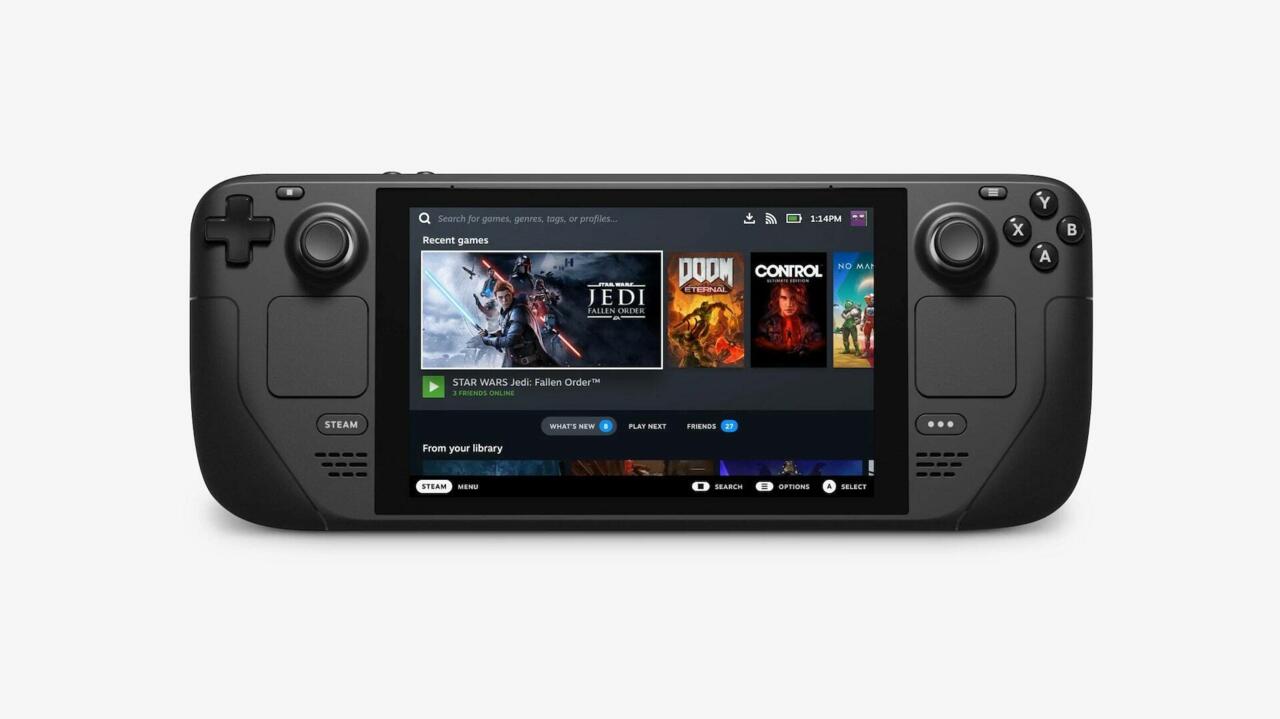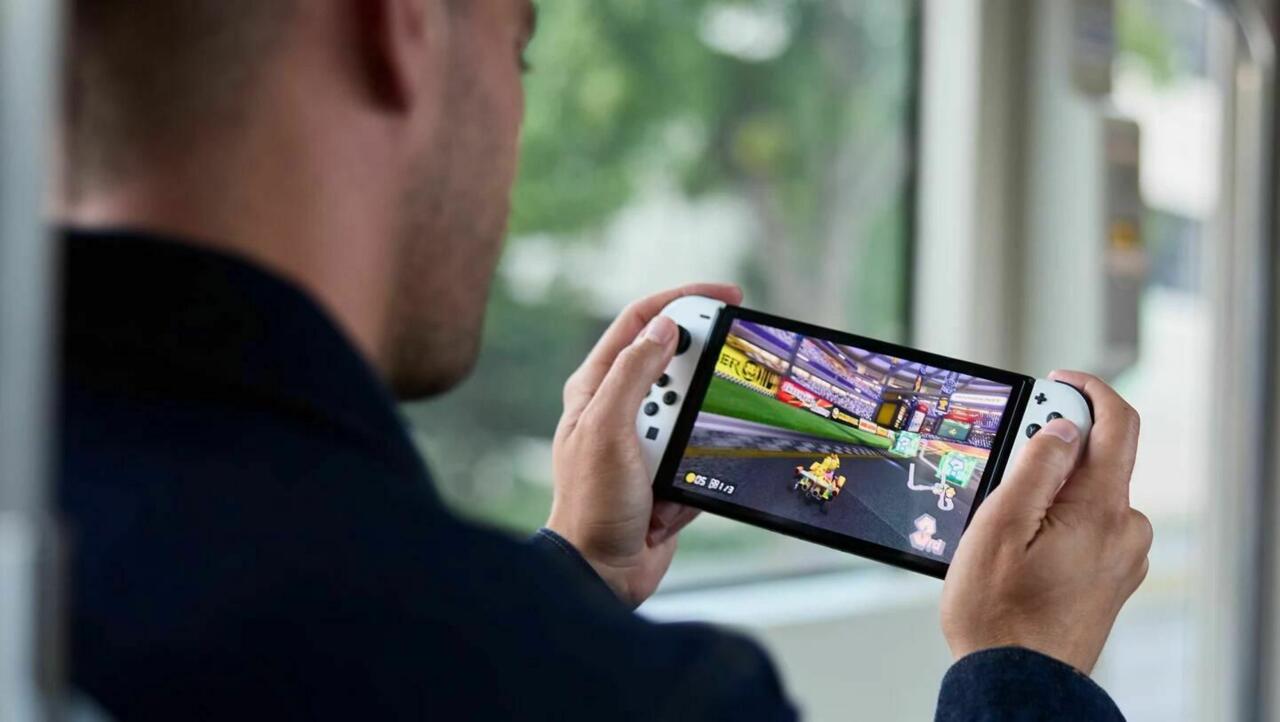Nintendo Switch Vs. Steam Deck: Which Handheld Is Right For You?
The Nintendo Switch and Steam Deck pull from the same design ideas, but the two handhelds are vastly different products. Here's what you need to know.
Nintendo might not have announced the rumored Nintendo Switch Pro earlier this month, but you could make the argument that Valve came in to save the day with its own portable gaming device, the Steam Deck. Like the Nintendo Switch, this is a gaming-first device that can be played on the go or docked to a larger display. Unlike the Nintendo Switch, however, this is an open PC platform, making the two devices rather different to use.
Still, it's hard not to compare the two, especially when both seem like fantastic platforms for the wide range of games supported on each, from small indie titles to large AAA blockbusters. But just how different are they from a hardware perspective? And just what can you expect when booting them up next to one another?
We're comparing the Steam Deck, original Nintendo Switch, and the new Nintendo Switch (OLED model) to help you make the correct decision, or at least better describe how similar and drastically different these two platforms are.
Display
When playing portably, the differences between the Nintendo Switch and Steam Deck are small. The original Nintendo Switch comes with a 6.2-inch display, while the new OLED model bumps that up to a 7-inch display. That includes a new OLED panel, which will be a huge improvement in terms of color reproduction and contrast levels when compared to the LCD panel of the original model.
The Steam Deck comes somewhere in the middle, then. It's also a 7-inch display, but the same type of LCD panel as the older Switch model. All three models top out at 60Hz but offer slightly different resolutions. Both Switch models are 1280x720 displays, with a traditional 16:9 aspect ratio, while the Steam Deck offers a slightly taller display with a 1280x800 resolution, which gives it a 16:10 aspect ratio. That might cause some incompatibility with games that don't cater to different aspect ratios, but it's not likely to be a big issue.

GPU and CPU
Perhaps the biggest difference between the Nintendo Switch and Steam Deck rests with their respective internals, with Nintendo opting for a GPU from Nvidia while Valve is going with AMD. Both the original Nintendo Switch and new OLED model have the same internal processing units, which is all bundled into a single custom Tegra APU from Nvidia. Nintendo doesn't offer many details beyond that on its official specifications sheet.
The Steam Deck is a little more forthcoming. It features an AMD APU that contains a Zen 2, quad-core processor that operates between 2.4 and 3.5GHz. More importantly, it also contains a new RDNA 2 GPU (the same architecture present in the PS5 and Xbox Series X|S) with eight compute units and around 1.6 teraflops of processing power. There's no question that the Steam Deck is a more powerful device on paper, but how that all translates to gaming performance across a range of PC titles has yet to be determined.
Internal and Expandable Storage
The Nintendo Switch was criticized for its lack of internal storage at launch, with the new OLED model only slightly rectifying the matter. The original model features only 32GB of storage, while the OLED model bumps that up to 64GB. This is somewhat offset by the generally smaller game sizes considering they have been optimized specifically for the console, while this won't be the case for the majority of PC games available for the Steam Deck (at least in the short term.)
The Steam Deck features a lot more storage, especially if you're willing to pay more. The base model comes with 64GB of eMMC storage, which might not be the best option for games, but the two more expensive options increase this to 256GB and 512GB NVMe SSDs respectively. This will certainly come in handy for the size of modern PC titles which often break triple digits.
Both the Nintendo Switch and Steam Deck can have their storage expanded using microSD cards, with the same SDXC and SDHC formats supported across both. The Steam Deck additional supports the standard SD format.

Controls and Input
Perhaps the most exciting thing about both the Nintendo Switch and Steam Deck is the ability to rely on good controller support for portable play. This has been one of the biggest draws for the Nintendo Switch, with the OLED model not changing anything up in that regard. You still get the segmented D-Pad on the left Joy-Con, four face buttons on the right, and asymmetrically placed thumbsticks across both. The Switch features two triggers and two shoulder buttons, both of which are digital.
The Steam Deck has a similar layout, albeit with thumbsticks that are positioned higher up the device and symmetrical. The D-Pad isn't segmented, either, but the device features the same four face buttons on the right. Things differ when it comes to the triggers, both of which are analogue to allow for more control (the shoulder buttons are still digital.) The back of the device also features four additionally buttons that will be familiar to users of controllers like the Xbox Elite Controller. On the front, Valve has also included two touchpads that the company says are an improvement over the company's attempts with the Steam Controller. This is meant to make games that are traditionally played with a mouse easier to control. Valve says both can be used for dual-thumb typing, too, if that's your thing.
Connectivity
Both being portable devices, the differences between the Nintendo Switch and Steam Deck in terms of connectivity mostly come down to the availability of more modern components. For example, the Nintendo Switch features a Bluetooth 4.2 chip, while the Steam Deck offers Bluetooth 5.0, which will come in handy for Bluetooth headphones and lower latency codecs. The Steam Deck also offers wider support for Bluetooth controllers, although that's mostly down to its operating system.
Both consoles feature a 3.5mm auxiliary port for output audio, USB-C for charging and docking, and a slot for microSD card expansion. Both feature Wi-Fi connectivity, too, but only the Steam Deck will connect to 5GHz bands if you use them.

Battery Life
Battery life on both the Nintendo Switch and Steam Deck will depend on the games you're playing, with estimates varying wildly between the two. The Nintendo Switch features a 4310mAh battery, with Nintendo saying it should last anywhere between four and a half to nine hours on a single charge. The Steam Deck battery is rated at 40Whr, which is impossible to compare to the Switch's mAh rating without knowing the exact operating voltage, but Valve says it'll last between two and eight hours. So it's likely both won't last a long flight.
Dock and TV Output
Just like the Nintendo Switch, the Steam Deck offers a dock that can be used to output the console to a larger display. The Switch Dock is slightly different depending on whether you go for the original or new OLED one. The original comes with three USB-A 2.0 ports (two on the side and one of the back), as well as HDMI out and USB-C for power. The OLED model is virtually identical, albeit with one fewer USB 2.0 port and an included Ethernet port instead. The output of the Switch dock tops out at 1080p, and that hasn't been changed with the new dock that comes with the OLED model.
Unsurprisingly, the Steam Deck dock is far more versatile. It features two outputs, namely HDMI 2.0 and DisplayPort 1.4. There are also three USB-A ports in total, with two 2.0 ports and a single 3.1 port. As expected for a PC, there's an Ethernet port, too, as well as USB-C for power. It should be noted that the Steam Deck doesn't require the dock in order to output to a larger display, with the USB-C port on the Steam Deck itself allowing for a signal to be output directly. Additionally, you will be able to use any USB-C docks that are widely available for laptops, too. This allows for up to 8K, 60fps video output, or 4K at 120fps. The Switch cannot output to another display without its dock.
It should be clear that the Nintendo Switch and Steam Deck are fundamentally different devices despite sharing a common design philosophy, and that's without even going into the differences between Nintendo's closed-down Switch operating system and Valve's open approach to allowing customers to install whatever OS they want. You're going to have to consider a lot more than raw technical specifications to decide which one will work with your particular gaming use case, but both have their own advantages over one another depending on what you're looking for. The Nintendo Switch OLED launches on October 8, while the Steam Deck is expected to start shipping in December.
Technical Specifications
| Nintendo Switch | Nintendo Switch (OLED model) | Steam Deck | |
|---|---|---|---|
| Display | 6.3-inch LCD, 1280x720, 60Hz | 7-inch OLED, 1280x720, 60Hz | 7-inch LCD, 1280x800, 60Hz |
| CPU/GPU | Nvidia Custom Tegra APU | Nvidia Custom Tegra APU | AMD Custom APU (Quad-Core Zen 2 CPU, RDNA 2 GPU) |
| RAM | 4 GB LPDDR4 SDRAM @ 1600 MHz | 4 GB LPDDR4 SDRAM@ 1600 MHz | 16 GB LPDDR5 RAM |
| Storage | 32GB Internal, microSD expandable up to 2TB | 64GB Internal, microSD expandable up to 2TB | 64Gb eMMC, 256/512GB SSD internal, microSD expandable |
| Connectivity | Bluetooth 4.2, Wi-Fi (2.4GHz) | Bluetooth 4.2, Wi-Fi (2.4GHz) | Bluetooth 5.0, Wi-Fi (2.4GHz and 5GHz) |
| Battery Life | 4.5-9 hours | 4.5-9 hours | 2-8 hours |
| Audio | Stereo, 3.5mm headphone/microphone jack | Stereo, 3.5mm headphone/microphone jack | Stereo, dual microphone, 3.5mm headphone/microphone jack |
| Size | 173mm x 102mm x 14mm | 173mm x 102mm x 14mm | 298mm x 117mm x 49mm |
| Weight | 399 (with Joy-Con) | 417g (with Joy-Con) | 669g |
Got a news tip or want to contact us directly? Email news@gamespot.com
Join the conversation